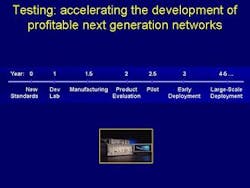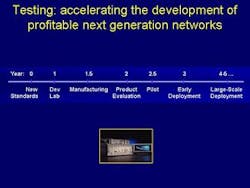Performance analysis accelerates the promise of the metro
Key test considerations can optimize optical deployments.
By MARK FISHBURN
Spirent Communications
Unforgiving current economic conditions do not offer metropolitan network service providers (NSPs) many second chances. On one hand, investors are putting tremendous pressure on optical service providers and manufacturers to roll out new, profitable technologies as quickly as possible. On the other, end-user intolerance for disruption in their optical network service means that existing and emerging technologies have to work correctly from the first moment they are commercially implemented. As a result, testing has rapidly evolved from a serious tactical exercise to become a vital strategic consideration in optical product development and service deployment. Nowhere is this more true than in metropolitan networks.
Given these new realities, network device manufacturers and service providers must integrate testing into their product and service development processes to manage the increasing complexity of optical metropolitan networks in a cost-effective manner.
Economic forces in metro networks
The challenges faced by metro players have served to protect them from the worst of the current economic environment. A recent report from Communications Industry Researchers Inc. (CIR) (Charlottesville, VA) states that the market opportunity for networking vendors supplying SONET, DWDM, and optical Ethernet transport systems in the U.S. metro core will top $2.5 billion in 2005, driven by the increasing diversity of ports within the space. CIR envisions continued pressure on capital spending for metro carriers, but the firm also notes a silver lining in the area of wholesale wavelength services.
Metro NSPs are affected by the economic downturn to a lesser extent than are core network service providers. Few metro service providers have engaged in the type of cost cutting programs experienced by long-haul carriers throughout 2001, nor have they decimated their capital spending initiatives. Nevertheless, they face serious macro-economic pressures that have resulted in hiring freezes, and are increasingly prudent about spending precious cash reserves.
From a technology standpoint, metro NSPs remain under continuous pressure to deliver increased bandwidth. Many metro NSPs have Frame Relay and ATM networks in place, which present persistent bottlenecks for enterprises that want seamless WAN integration. These enterprise customers not only need to integrate branch offices around the world, but also provide high-speed access to telecommuters, field sales reps, and engineers who must have the same access to corporate information and communications as their colleagues located in office campuses. Considering that the average desktop PC runs on 100-Mbit/sec Ethernet connections and that the typical metro NSP offers access speeds of 45 Mbits/sec, there is clearly a huge disparity to resolve.
One of the hottest applications driving demand for metro bandwidth is storage. In the wake of September 11, a growing number of metro NSPs are teaming up with storage service providers to offer robust remote backup capabilities to small, medium, and Fortune 1000 companies. This has led to a spike in demand for networking capabilities that allow companies to self-provision different levels of bandwidth in a dynamic manner. Companies want to run their networks at typical bandwidth levels during normal business hours, and then ramp up access after hours to support remote backup operations to off-site locations.
All of these trends contribute to the rapid increase in the complexity of metro network operations. This is especially true as NSPs invest in new technologies, protocols, and quality of service (QoS) network service offerings such as voice, video, data, and virtual LANs. Thus, despite the current economic climate, the increasingly complex networking environment has rendered unavoidable the development of testing technologies, procedures, and methodologies.
These market and technology forces are, in fact, generating demand for a new breed of testing solutions that not only test point technologies, but also test the way point technologies interact with other elements and diverse technologies within metro networks (Figure 1).
The evolution of this complexity has been rapid. When metro NSPs first came on the scene, they typically deployed a fairly homogenous network based on either Frame Relay or ATM technology. Traffic may have merged into a SONET/SDH ring at some point in the network landscape, but network administrators could basically test the entire environment with an array, Frame Relay, or ATM cards that would generate traffic to stress different elements in the network. Network operators could develop a comprehensive picture of performance levels in this fashion because it was essentially a homogenous network. When problems were detected, it was relatively simple to go in and inject traffic at surrounding ports on the network to isolate where problems occurred.
A few years later, we find ourselves in a completely different situation. Now, customers may enter the network on Layer 2, while the service provider continues to manage what is essentially Layer 1 optical point-to-point connections. Enterprise customers are loading different types of traffic such as Frame Relay, Ethernet, or channelized packet over SONET/SDH (POS) at different rates--from 10 Mbits/sec to potentially 10 Gbits/sec. This has significantly complicated the way traffic is managed and groomed to share optical ring resources. Managing the environment has become infinitely more complex.
Today, testers must track exactly how different types of traffic behave in the network instead of counting packets on one side and then the other side, the way metro NSPs tested for performance in the early years. They must determine whether different types of traffic are effectively mapped for appropriate output to the optical ring. And, beyond the basic problem of trying to locate where a problem is taking place geographically on the network, test partners need to determine what kind of traffic is not flowing properly over the network. As a result, troubleshooting in a live metro network environment is now as much an art as it is a science (Figure 2).
In responding to dynamic new realities, metro NSPs have options. They can continue to do what they have traditionally done, to buy point-solution testing tools for each technology or protocol component in their network. If they do, they need to hire and train skilled technicians to monitor, test, and troubleshoot traffic on a technology-by-technology and protocol-by-protocol basis. There is a fatal problem with this approach--it is not scalable, especially in the current economic climate.
Another solution is to buy more comprehensive suites of integrated solutions that simultaneously track, test, and troubleshoot multiple technologies. While this approach is more complicated, it allows metro NSP test engineers to compare and contrast diverse technologies in real time, which is critical to resolving performance problems in a live metro network. The skill sets required to operate, manage, and resolve network problems with these tools are admittedly substantially higher. However, expertise is available on a for-hire basis, and metro NSPs may even want to consider outsourcing portions or the entire testing function to organizations with the ability to manage complicated testing paradigms.
Predictions
Given today's economic realities, which prevent metro players from "staffing up" to deal with the rising complexity of their networks, outsourcing testing functions may indeed become a prevailing trend among metro NSPs.
It is becoming increasingly clear network operators that it is neither economically nor operationally efficient to adopt technologies and then acquire testing solutions. It is therefore reasonable to expect that metro NSPs will demand suites of testing technologies able to manage multiple technical environments in a dynamic fashion.
If either, or both, of these trends become a reality, metro NSPs will be forced to rethink how testing is incorporated into their service, technology development, and deployment strategies. Clearly, testing will be an even more vigorous consideration on the front end of the network architecting process, requiring important decisions regarding how network equipment manufacturers and testing providers can be integrated into metro NSP business plans.
Mark Fishburn is vice president of technical strategy for Spirent (Calabasas, CA). Fishburn has more than 30 years of experience in the computer and data communications industries. He formulates communication and drives business and technology strategies for Spirent. He can be contacted at [email protected].

